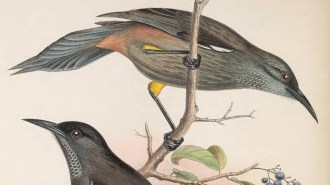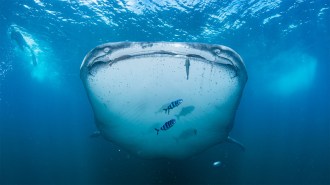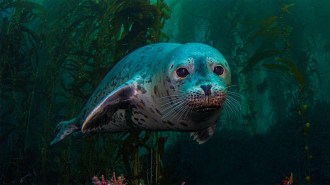Bad-News Beauties
Poison-spined fish from Asia have invaded U.S. waters
With striking red, black, and white stripes decorating its body, fins, and some dozen spines along its head, back, and sides, the red lionfish is at once beautiful and frightening. The football-shaped fish can grow up to 18 inches long and is poisonous to the touch. At smaller sizes, this subtropical fish from Asia is extremely popular for hobbyists with saltwater aquariums, but the red lionfish is a major worry to government biologists charged with protecting native species in the wild.
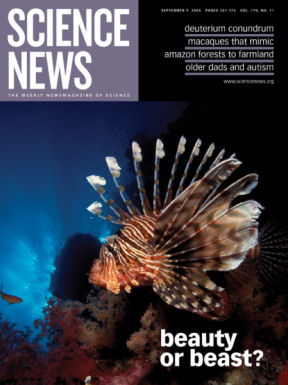
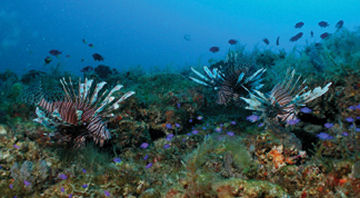
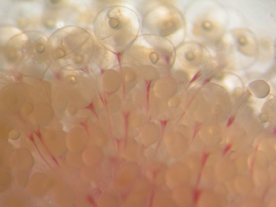
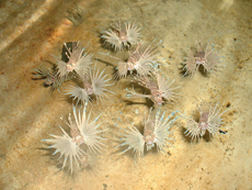
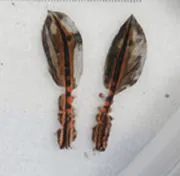
In the past decade or so, the lionfish has increasingly shown up along the U.S. coast from North Carolina to Florida, where it could spell big trouble for the domestic fish whose ranges it’s invading.
There are several scenarios by which this fish could have entered the coastal waters. Many biologists point to Hurricane Andrew in 1992 as the agent behind the first release. Its destruction included an aquarium that had housed six red lionfish in a Miami home on Biscayne Bay. Several of the vividly striped survivors were spotted in the bay shortly thereafter.
Red lionfish were swimming freely along the U.S. coast long before that, says Walter R. Courtenay, a fisheries biologist at the U.S. Geological Survey in Gainesville, Fla. He proposes as the earliest North American sighting a red lionfish that an oceanographer identified during the mid-1980s after it was caught from a pier in Lake Worth, Fla.
There could have been several lionfish releases, at least some of them deliberate, biologists now suspect. For instance, hobbyists might have released pet lionfish that had outgrown their aquariums. Another possibility is that dive-boat operators may have released red lionfish, perhaps purchased at a pet store, to establish a population for their customers to observe. Courtenay notes that several excursion operators brag that they can take tourists to see red lionfish, a species that scientists can have trouble locating in the sea.
The biologists generally rule out ships’ ballast tanks, which have carried many other species that became invaders once they were released far from their native waters. Few tankers and freighters come to the southeastern United States from the red lionfish’s native range in the South Pacific, Indian Ocean, and Red Sea.
Regardless of when or how red lionfish got their start in the Western Hemisphere, the fish have become well established. New research indicates that they’re breeding, growing faster than they do in their home range, and proving unappetizing to would-be predators. The latest reports indicate that the species has now spread to Bermuda and the Bahamas.
Ever bold
Few know the red lionfish (Pterois volitans) as well as Lev Fishelson does. For more than 40 years, this marine biologist at Tel Aviv University in Israel has studied the species in the Red Sea, the westernmost portion of its native range. What have always struck him about the fish are its grace and “fearlessness.”
Unlike most reef denizens, red lionfish will approach divers rather than veer away. Fishelson warns that the animal will sometimes launch itself into a person. If the needlelike tip of a spine breaks the diver’s skin, he or she will experience intense pain and swelling at the wound site and usually end up in the hospital, says Fishelson.
A member of the scorpionfish family, this lionfish has a reservoir of venom at the base of each of its spines. If the spine is pushed inward, the pressure on the venom gland triggers toxin to shoot up the hollow spine to its tip, explains reef biologist H. Scott Meister of the South Carolina Department of Natural Resources in Charleston.
Because the process is entirely mechanical, he adds, handling even a dead red lionfish can release its venom.
While keeping a polite distance, Fishelson has had the rare privilege of witnessing the red lionfish’s courtship. Initially, he reports, the normally solitary animals begin collecting into groups of more than a dozen. For 3 to 4 days, males will posture before prospective mates. This entails darting forward and thrusting spines atop its head at a rival.
When adequately impressed, a female will join her suitor and commence a spawning dance. Face-to-face, they’ll circle just above the seafloor. Eventually, the couple will slowly ascend the water column, continuing its waltz. Just before reaching the surface, the female will expel a mucus ball, containing thousands of eggs, which floats to the surface. Her companion, Fishelson says, responds by turning belly up and releasing a cloud of sperm into the egg ball.
Then, as if the music were over, the dancers suddenly go their separate ways.
Within a day, at least in the Red Sea, Fishelson says, those eggs will have hatched into larvae and migrated to hideouts among the algae growing on the seafloor. Three months later, they are miniature versions of the parents.
Tanked
Although previously spotted in Florida, red lionfish hadn’t been sighted off North Carolina until 6 years ago. Just 2 years later, in 2004, National Oceanic and Atmospheric Administration (NOAA) researchers in North Carolina reported the first evidence that the species was reproducing along the U.S. coastline. That finding all but ruled out the prospect of eliminating the immigrants, the scientists say.
NOAA has since launched a program aimed at evaluating whether the invader poses any risk to commercially important, native western-Atlantic fish. Little research had been published on the red lionfish, so the biologists had to first describe the fish’s lifecycle, diet, and likely predators. Last May, the researchers presented many of their preliminary findings at the International Conference on Aquatic Invasive Species in Key Biscayne, Fla.
“The interesting thing about invasive species is that it’s not uncommon for them to actually get bigger or do better in a new habitat” than in their native range, says Paula Whitfield of NOAA’s lab in Beaufort, N.C. From all accounts, individual red lionfish off the Carolinas are growing much faster than native fish do. The phenomenon may reflect more food for the fish, fewer predators, or accommodations nicer than home in other ways.
Although baby red lionfish have been seen in late summer or fall as far north as Long Island, N.Y., Whitfield says that these fish can’t survive the winter there. In her lab, the species dies when the water temperature drops below 10°C (50°F).
However, 20 miles east of Cape Hatteras, N.C., at depths of 100 to 160 feet, temperatures would remain hospitable to red lionfish year round. Sampling 27 sites there during a recent scouting expedition, her group found red lionfish at every location except one. The team is now examining the 150 specimens that it collected.
Jennifer Potts, also of NOAA’s Beaufort lab, is figuring out how old individual fish are. She has examined calcium deposits, called otoliths, in their ears. The deposits add layers, like tree rings, as a fish ages. “What I’ve found—and this is very preliminary—is that my oldest fish appears to be 7 years old,” she says. That fish is 17 inches long.
Other fish that she estimates at 2 years old are already 10 inches long, she adds. Examinations of gonads from wild fish have indicated that individuals of this species are sexually mature by the time they’re 7 or 8 inches long.
Indeed, among the 130 red lionfish collected last month during a 9-day cruise off the Carolinas, James A. Morris Jr. of NOAA’s Beaufort lab found indications that yearling females were already spawning.
A mature female may release a pair of egg balls about five times each month “from spring to fall off of North Carolina, and possibly year-round off of Florida,” notes Morris.
Red lionfish could have a selective advantage over native fish along U.S. reefs. Not only would the lionfish quickly become too big for many medium-size fish to eat but they would also start preying at a young age on those fish, Potts says.
Morris finds that native fish don’t seem much interested in eating even tiny red lionfish. This past June, for instance, he offered a 2-inch-long red lionfish and a similar-size native reef fish to 1-foot-long black sea bass. In 20 trials, the bass ate every native fish but, in 16 of those tests, it shunned young red lionfish. Sometimes, a bass took a red lionfish into its mouth, but it usually spit out the small fish.
What’s for dinner?
In the waters off South Carolina 4 years ago, biologists noticed lionfish specimens around 7 inches long, says David M. Wyanski of the South Carolina Department of Natural Resources. Now, red lionfish encountered there can be 17 inches long and weigh 3 pounds.
What are they eating to grow so robustly? Roldan C. Muñoz at NOAA’s Beaufort facility has examined the mouth and stomach contents of 88 red lionfish captured in the Atlantic Ocean. Muñoz found that these lionfish had been eating the occasional sea urchin, brittle star, crab, shrimp, and mollusk. However, 97 percent of the lionfish diet had been other fish, especially small sea bass and parrotfish.
Although Muñoz didn’t find evidence that lionfish were dining on groupers or snappers, which like bass are commercially important fish, the invaders may still threaten those populations. Native groupers off the Carolinas eat black sea bass and parrotfish, Muñoz notes, as the red lionfish do.
Meanwhile, red lionfish may soon end up on some people’s dinner plates. Wyanski points out that this year those fish were caught in such quantity that boat operators along the Carolinas started including them in boxes of “mixed catch” sold skinned and sometimes filleted to consumers at a discounted price. The toxin from red lionfish poison glands doesn’t taint the meat, he says.
What now?
Recently, NOAA scientists began genetic studies of red lionfish to determine how many separate releases in the Atlantic have occurred. Whitfield says that her team is finding evidence of a “severe genetic bottleneck,” suggesting that perhaps no more than three pregnant females launched the expanding western-Atlantic red lionfish population. The data point out, says Whitfield, how large an impact the introduction of even a few aliens can have.
The evidence is strong that the red lionfish and similar invaders came from the aquarium trade, says Brice X. Semmens of the University of Washington in Seattle. He and his colleagues found that the 16 nonnative fish—including red lionfish—most often seen by divers in the Atlantic Ocean off Florida are all common saltwater-aquarium species that probably moved into that state for the hobbyist trade. There’s little ship traffic between the southeastern United States and the native waters of any of those species.
Additional data also point to the aquarium industry as the culprit. In the first 6 months of 2003, for instance, more than 7,500 red lionfish were imported into Tampa, according to Whitfield and a team of scientists at the Florida Fish and Wildlife Research Institute in St. Petersburg. They reported in the March Biological Conservation that this species is among the top 10 saltwater fish, in terms of profitability, to the U.S. aquarium industry.
Three years ago, Whitfield and Jonathan A. Hare, also of NOAA, prepared a report on red lionfish for their agency. In it, they argued that the aquarium industry “should be urged or required to distribute information warning against releasing live fish from aquariums.” Government agencies might also consider banning the importation of live, nonnative fish—something that Bermuda now does.
In the meantime, Meister jokingly suggests a transitional strategy: recruiting coastal chefs to develop recipes for red lionfish. Everyone knows that “as soon as a fish tastes good, there’s a market for it”—and soon, he quips, you see it fished to oblivion.
Lion or Peacock?
Unusual tentacles are becoming more common among juveniles
The typical juvenile red lionfish has fleshy, striped, spear-shaped tentacles protruding from its head behind the eyes. However, beginning some 40 years ago, Lev Fishelson of Tel Aviv University occasionally found immature members of the Red Sea population that were sporting fringed or feather-shaped tentacles that were emblazoned with eyelike dots. “They look like peacock feathers,” he notes.
In recent years, the frequency of lionfish with the variant tentacles has been increasing—to about 10 percent of juveniles. Fishelson described the evolution of this trait in the March Environmental Biology of Fishes.
After reading that report, James A. Morris Jr. of the National Oceanic and Atmospheric Administration looked for the peacock variant among the 130 red lionfish that his team picked up last month during a cruise off the Carolinas. Among these fish, some 25 percent of juveniles sported the variant tentacles. “So, we’re seeing a higher prevalence of these peacock tentacles in the Atlantic than Fishelson has reported finding in the Middle East,” Morris says.
A fish’s peacock tentacles send a signal to some other animal, Fishelson told Science News. For instance, the small dots may look to another fish like tiny prey and might lure it to within striking distance of the juvenile lionfish, which has a huge mouth. Fishelson argues that the new trait’s increasing frequency suggests that it offers its hosts some as-yet-unrecognized benefit.

